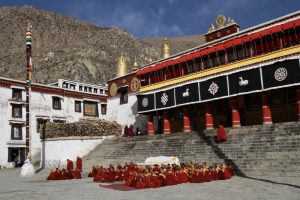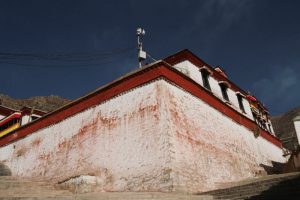 Located in the foothills of the western suburbs of Lhasa, Drepung Monastery is the largest temple in Tibetan Buddhism. The temple’s architectural complex is large in scale, with white houses and red palaces lined up on the mountainside. From afar, it looks like a huge pile of rice. The photos of Drepung Monastery taken on the mountainside are very spectacular. It is the highest-ranking temple in the Gelug Sect of Tibetan Buddhism. The interior architecture is atmospheric and magnificent, which is full of many beautiful treasures, and the Monk’s debate ceremony can be watched there.
Located in the foothills of the western suburbs of Lhasa, Drepung Monastery is the largest temple in Tibetan Buddhism. The temple’s architectural complex is large in scale, with white houses and red palaces lined up on the mountainside. From afar, it looks like a huge pile of rice. The photos of Drepung Monastery taken on the mountainside are very spectacular. It is the highest-ranking temple in the Gelug Sect of Tibetan Buddhism. The interior architecture is atmospheric and magnificent, which is full of many beautiful treasures, and the Monk’s debate ceremony can be watched there.
Visiting Drepung Monastery must firstly arrive at the mountain gate of Drepung Monastery. In front of the mountain gate, you can see that the temple is in the middle of the mountain. It is surrounded by mountains on three sides, facing the Lhasa River. The buildings are layered spectacularly, which looks like a white mountain city. After entering the Drepung Monastery, you can see the Tibetan architecture in the temple at a close distance. The houses are all surrounded by white walls, and the halls along the Golden Summit are scattered. They are all Tibetan characteristics. The temples in Tibet are different from that of the Han dynasty in the mainland. They are not symmetrically arranged in the central axis, but scattered in the mountains. They can be viewed clockwise along the road. The total circumference of Drepung Monastery is about 2 kilometers, and it is not tired even though you visit there by walking. Winding around the temple clockwise is also a way to pray for yourself to accumulate good business.
Drepung Monastery has the highest status in the temple of the Gelug Sect in Tibetan Buddhism. It has caught the attention of the Dalai Lama and is presided over the construction. The halls of each temple are majestic. Among them, the temple’s large hall has 183 columns, featuring the beautiful carvings on the column. The Buddha statues in the temple are solemn and noble, and there are also a large number of exquisite art treasures such as Thangka, pile embroidery and murals, which can be seen one by one there.